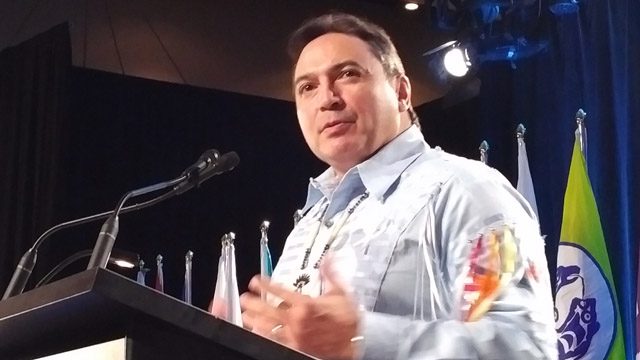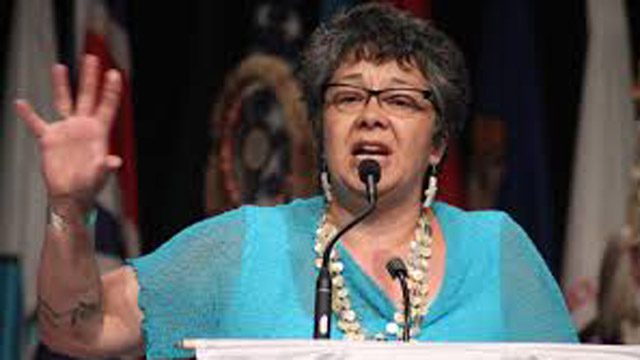Joan Jack
Special to APTN National News
Misogyny means veiled women hating behavior, but what does misogyny mean in our culture and in our communities today? It means that we are being left out.
Many Indigenous people, however, are not conscious of how they are actively misogynist or how they are passively contributing to perpetuating misogyny. That’s where I started.
I was not aware of my own self-hate or how my own behavior contributed to my oppression as an Indigenous woman. Today, I understand that what misogyny boils down to is the unfair distribution of power because, in reality, most people with the power don’t instinctively or willingly like to share their power and, in that respect, our Indigenous men are no different.
Oh, Indigenous men, especially our leaders, pay a lot of lip service. For example, saying how we are the life givers and say we are more powerful than them and that we should walk in front when we are marching.
To that end, most recently, at the Assembly of First Nations Chiefs in Assembly gathering, our national chief shared with the world via “live stream” that we, women, are one of the Sacred forms of water because we create the water within our bodies where every human life begins. But, how does that powerful truth, that powerful spiritual understanding and philosophical reality actually manifest in the daily lives of Indigenous women in our communities, on and off reserve? It doesn’t.

The biggest challenge we face as women in our communities is a double-edged sword and both edges are seriously “Sacred Moose”!
First, and especially outside Canadian cities, we have the Born Again Christian movement that spreads the idea that being made from a man’s rib, we women are somehow “less than” and thus not meant for leadership.
And, second, we have the traditionalists who, ironically, also say that a woman’s place is “traditionally” not in leadership and that we can’t wear headdresses.
Both these perspectives tell us as Indigenous women that we are to be content to be the “real” power in the background and to do anything else as a woman is seriously frowned upon and suppressed through clear and deliberate misogynistic behavior manifesting in isolation and unemployment for many of our most powerful and intelligent Indigenous women.
However, thanks to the pain and hard work of the families who have lost their loved ones, the world now knows the misogynist truths of our communities. The world now knows we are murdered and missing more than other women in Canada, simply because we are Indigenous women. And, most recently, the world is learning how police forces in Canada routinely abuse us; apparently again just because we are women and especially because we are Indigenous women.
But, rather than calling for an end to male violence against women, our Indigenous leaders are calling on us to modify our behaviours as Indigenous women as if we are the problem.
So, where I see the link to misogyny and our leadership is in the fact that no one really likes to talk about the truth that much of the male violence against women we live or die with is the violence of the men we know, love, elect or hire within our communities. And, for me, and for most at the end of the swinging fist, it is no longer enough to say “oh, but our men have been so hurt by colonization”. I’m just plain tired of that bullshit excuse.
We’ve all been hurt and continue to be hurt through Canadian colonial legalized racism and the colonizers correspondence is addressed specifically to the chief, who is usually a man, and often no one else sees the mail, not even the councillors!
Of course, there are exceptions in our leadership – good chiefs, like Chief Clarence Louie who has gotten famous for saying that our people should “get over it and get a job”! I agree with him and add that our Indigenous leaders should get over being threatened by powerful intelligent Indigenous women and get some therapy because we women can read and write now, too.
Because it’s 2016.
I’m not here to beat up our men. I’m here to say “move over”. I’m here to say that in this day and age, in this time, we as Indigenous women must take our rightful place; which is wherever the hell we think that should be.
Just like the women we saw at Oka over 20 years ago and see at Standing Rock today, we Indigenous women are not afraid to fight for our land.
We are fierce and are mothers.
But, what we are not doing in large enough numbers is braving the violence in our own homes. We must be willing to draw the line as women – I know – I’ve done it – I’ve risked my own life to end violent relationships. I’ve stood my ground until I found I was standing beside a man who respected me in whatever way I chose to express myself. In fact, we just celebrated 24 years of marriage.
Outside our homes, in our communities, seeking political office is a little more challenging as Indigenous women and the misogynist facts are reflected in the small numbers of us in formal leadership. On this front, my advice to all voters and especially to our women who make up at least 50 per cent of the voters is – stop electing your dumb cousin.
Elect people of all genders, including LGBT, who are actually not self-interested and fear-based and are capable of doing the work that we need done for the good of all.
In closing, this came to me today – So the birch tree says to the spruce tree, “Hi, I’m a birch tree.” And the spruce tree says, “Oh, I don’t care that you’re a birch tree, I only see trees. We’re all just trees. We’re all the same.” Birch tree “Huh? WTF?”
This Oped was reviewed, edited and approved by Elder Jacinta Wiebe, B.A. ABV, B.Com.Hons
About the Author: Joan Jack is Aanishinaabe Ikwe, from the Berens River First Nation, which is a fly-in community located approximately 270 air kilometres north of Winnipeg on the eastern shore of Lake Winnipeg in Manitoba and is the eldest daughter of three children and lived in Berens River until she left home for high school and college/university. Though she left her home in Berens River to attend high school in Winnipeg at the age of thirteen, Mrs. Jack has maintained a strong and clear dedication to her people, her community and land. Jack is a lawyer and in 2012, ran unsuccessfully for the National Chief of the Assembly of First Nations.











We are fighting for our lives. We are fighting for our right to live and raise our families in our communities and to stay on the land. We are fighting for life. Water is life. We can’t keep paying these high prices. The prices keep getting higher and the services are diminishing. We just can’t do ti. That is the truth. High pricing in the North is a complete disservice to Indigenous People. There are thousands of homeless people. We have people dying out there on the streets. There is a mass exodus of our people fleeing the reservations. They have fled the reservations and are pouring by droves into nearby cities and towns. The cities are ill equipped to deal with the scope and hazards of this exodus. We are at risk more than ever before and the risks are greater. We rush to every calamity and circumstance of disaster but only when it is already too late. We rush to fix every situation as it arises. Absolutely everything is in crisis. What exactly is going on? There is a systemic failure within our society causing calamity and wreaking havoc. What is causing the exodus of people fleeing the reservations? What is the systemic root cause of this disaster? We have to address the real concerns of the people. Just average ordinary people. What matters to them? We want to keep the water clean. We want to clean up the environment and retain habitats. Not just for mankind but for the wildlife too. Keeping Mother Earth beautiful. We have to really talk to one another like we use to. I am not always or ever politically correct. A leader should never have to worry about that. Just tell it like it is. We have a lot of strong young Natives and smart ones too. We should get together as ,leaders and acknowledge them. We have people like Freda Huson, Ellen Gabriel, Myeengun Henry, and ordinary men and women who go to work and school, or simply watch the kids all day that are the real hero’s. We don’t wee them at the National Achievement Awards but they are my hero’s and I am acknowledging them. So what is leadership. Explain what the heck is going on? Get some answers. A great leader isn’t afraid to tackle the big issues. Joan Jack is leading in courage. I really liked this article and I look forward to more insightful straight talk.
Bravo Joan…. I wish I had been brave enough to say this… what most intelligent indigenous woman know in our hearts. … I humbly thank you from the bottom of my Indigenous woman being.
straight talk
You have to be an educated person and appeal to the people on your actions and what you do in certain situations. not just because you are a woman, or man or gblt to be a chief. Honesty a valuable asset and know the issues of communities not go along with anything that indian government agencies says this is good for u, when it works for some does not mean it works for others. Chiefs have lost the values, they once held high. We are now in the election modes in how we choose our elected leaders, who most of the time are elected by our families and friends. Fair is another good trait to have. eh When u are a CHIEF u must also know the TREATIES eh
in our way of life any chef that walks into a church should never be chief to begin with he or she does not follow the red road as for the head dress 90 percent of the chiefs shouldnt have one on their heads yet the eagle feathers are earned not just for adornment if they are not earned males as well shouldnt adorn them but she is right in our own communities women still have to fight to be even seen by the elder ones and we have a long way to go in equality especially when in our own beliefs the female actually is of a higher source than the man as she is the giver and bringer of life but most hold a blind eye to this even today its time clan mothers cleaned coucils regularly as needed instead of sitting back on their lorals